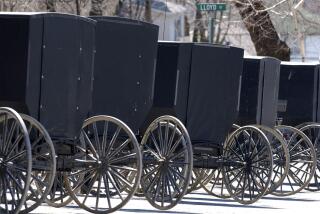But Development Erodes Customs of ‘Plain Folk’ : Amish Successfully Block State Highway
- Share via
INTERCOURSE, Pa. — The Amish won a major victory against state plans to build a highway through their fertile farm area, but development and an expanding population threaten the way of life of the “plain folk.”
Growing numbers of tourists, factory outlet stores, retirees and commuters to and from Philadelphia have squeezed the community, concentrated in a wedge between U.S. Route 30 and Pennsylvania 23, officials said.
“It looks to me as if we’ll get driven out if these things change in the next 20 years the way they did in the last 20,” said an Amish bishop, who for religious reasons spoke on condition of anonymity.
In the last 25 years, the number of Amish in Lancaster County has doubled to about 15,000, forcing more and more Amish men to leave the traditional farming life, said sociologist John A. Hostetler, author of “Amish Society.”
Strict Mennonite Sect
The Amish, members of a strict Mennonite sect, have avoided most of the 20th Century’s technological advances. They ride in horse-drawn buggies and don’t use electricity, telephones or motorized farm tools.
County officials had asked the state to build a highway to relieve overcrowding on Routes 23 and 30, which connect Philadelphia with Lancaster, 65 miles to the west.
In September, about 1,000 Amish broke their custom of aloofness from outside affairs by staging a silent protest against the project at a hearing.
State Transportation Secretary Howard Yerusalim announced in January that the highway will not be built.
Instead, the state will try to lessen crowding on Routes 23 and 30 by going ahead with a previously planned relocation of Route 23 between Lancaster and a Route 30 bypass and widening project, said Transportation Department spokeswoman Betty Serian.
Economic Pressure
The Amish have been affected by a shortage of farmland, rising prices for farms and the lures of non-farming jobs.
With Amish families averaging seven children, farmers often don’t have enough farmland to leave to their sons. Farms have been divided to as small as 35 acres and can’t be split up further, said Alan R. Musselman, director of the county Agricultural Preservation Board.
“(We’re) still getting more people and not more land,” said the Amish bishop.
In eastern Lancaster County, where farms are predominantly Amish-owned, land prices have jumped from about $5,000 an acre in 1984 to $7,200 an acre this year, said Hostetler.
“For the first time, we’re seeing Amish farmland selling for development,” Musselman said. “There have been offers so high that it didn’t make sense for them to refuse the offer.”
Without farmland to till, some Amish have moved elsewhere in the state, while a growing number have been forced into trades.
Fewer Men on Farms
In the last 25 years, the percentage of Amish men who farm has dropped from about 80% to 64%, said Hostetler.
Some even have taken factory jobs, which wasn’t allowed until recent years, said an Amish minister.
Tourism also has put pressure on the area. In 1987, the quaint life style of the Amish helped draw 3.5 million to 5 million tourists to the county, said Maria DiBattista of the Pennsylvania Dutch Convention and Visitors Bureau.
By the year 2000, Lancaster County’s population of about 400,000 is expected to reach 440,000, according to a county planning study.
Manufacturing employment was 59,900 in 1987 and should grow to more than 63,000 by 2000, said Janet Romanowski, research director at the Lancaster Chamber of Commerce and Industry.
More to Read
Sign up for Essential California
The most important California stories and recommendations in your inbox every morning.
You may occasionally receive promotional content from the Los Angeles Times.













